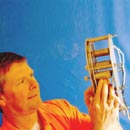Archive for 2002
Multi-Fingered Exoskeleton Haptic Device using Passive Force Feedback for Dexterous Teleoperation
- Тип контента: Научная статья
- Номер документа: 7365
- Название документа: Multi-Fingered Exoskeleton Haptic Device using Passive Force Feedback for Dexterous TeleoperationНе заполнено
- Номер (DOI, IBSN, Патент): Не заполнено
- Изобретатель/автор: Tatsuya Koyama, Ikuo Yamano, Kenjiro Takemura, Takashi Maeno
- Правопреемник/учебное заведение: Keio University
- Дата публикации документа: 2002-10-31
- Страна опубликовавшая документ: Япония
- Язык документа: Английский
- Наименование изделия: Не заполнено
- Источник: Не заполнено
- Вложения: Да
- Аналитик: Глаголева Елена
 A novel control methodology for master-slave systems using passive force feedback has been proposed by the authors. The methodology solves the conventional problems of previously developed master-slave systems with force feedback, such as oscillations, complex structures and compli-cated control algorithm. In the present paper, a multi-fingered exoskeleton haptic device (master hand) with passive force feedback function is developed. First, the exoskeleton master hand with three fingers (12 degrees of freedom) is designed and implemented. Each finger of the master hand consists of a link me-chanism with elastic-shaft joints and clutches. Using link mechanisms, the master hand measures fingertip positions and angles of index finger, middle finger and thumb. Furthermore, it also enables passive force feedback to an operator by the same link mechanism used for the geometric measurements. Then, a virtual reality system of human hand is constructed using the master hand and the control methodology. Using the system, sensory evaluations are conducted on human subjects to confirm the usability of the developed master hand and the possibility of the control methodology in the virtual reality system. As a result, the subjects possibly recognize the stiffness of the objects in the virtual environment.
A novel control methodology for master-slave systems using passive force feedback has been proposed by the authors. The methodology solves the conventional problems of previously developed master-slave systems with force feedback, such as oscillations, complex structures and compli-cated control algorithm. In the present paper, a multi-fingered exoskeleton haptic device (master hand) with passive force feedback function is developed. First, the exoskeleton master hand with three fingers (12 degrees of freedom) is designed and implemented. Each finger of the master hand consists of a link me-chanism with elastic-shaft joints and clutches. Using link mechanisms, the master hand measures fingertip positions and angles of index finger, middle finger and thumb. Furthermore, it also enables passive force feedback to an operator by the same link mechanism used for the geometric measurements. Then, a virtual reality system of human hand is constructed using the master hand and the control methodology. Using the system, sensory evaluations are conducted on human subjects to confirm the usability of the developed master hand and the possibility of the control methodology in the virtual reality system. As a result, the subjects possibly recognize the stiffness of the objects in the virtual environment.
Категория: Научные статьи | Нет комментариев »
Прикованным к постели помогут космические ботинки
- Тип контента: Новостная статья
- Номер документа: 2281
- Название документа: Прикованным к постели помогут космические ботинки
- Номер (DOI, IBSN, Патент): Не заполнено
- Изобретатель/автор: Не заполнено
- Правопреемник/учебное заведение: Не заполнено
- Дата публикации документа: 2002-10-08
- Страна опубликовавшая документ: Россия
- Язык документа: Русский
- Наименование изделия: Не заполнено
- Источник: http://www.membrana.ru/particle/11593
- Вложения: Не заполнено
- Аналитик: Ридна Украина)))
 Технология, посредством которой в Университете Хьюстона (University of Houston — UH) были созданы ботинки для астронавтов, в будущем может применяться и на Земле, чтобы помочь людям с повреждёнными мускулами ног — потерей их массы, силы и координации.
Технология, посредством которой в Университете Хьюстона (University of Houston — UH) были созданы ботинки для астронавтов, в будущем может применяться и на Земле, чтобы помочь людям с повреждёнными мускулами ног — потерей их массы, силы и координации.
Категория: Полезное | Нет комментариев »
Stair ascent and descent at different inclinations
- Тип контента: Научная статья
- Номер документа: 6458
- Название документа: Stair ascent and descent at different inclinations
- Номер (DOI, IBSN, Патент): Не заполнено
- Изобретатель/автор: Robert Riener, Marco Rabuffetti, Carlo Frigo
- Правопреемник/учебное заведение: Не заполнено
- Дата публикации документа: 2002-09-02
- Страна опубликовавшая документ: Не заполнено
- Язык документа: Английский
- Наименование изделия: Не заполнено
- Источник: Gait and Posture
- Вложения: Да
- Аналитик: Глаголева Елена
 The aim of this study was to investigate the biomechanics and motor co-ordination in humans during stair climbing at different in-clinations. Ten normal subjects ascended and descended a five-step staircase at three different inclinations (24°, 30°, 42°). Three steps were instrumented with force sensors and provided 6 dof ground reactions. Kinematics was analysed by a camera-based opto-electronic system. An inverse dynamics approach was applied to compute joint moments and powers. The different kinematic and kine-tic patterns of stair ascent and descent were analysed and compared to level walking patterns. Temporal gait cycle parameters and ground reactions were not significantly affected by staircase inclination. Joint angles and moments showed a relatively low but sig-nificant dependency on the inclination. A large influence was observed in joint powers. This can be related to the varying amount of potential energy that has to be produced (during ascent) or absorbed (during descent) by the muscles. The kinematics and kine-tics of staircase walking differ considerably from level walking. Interestingly, no definite signs could be found indicating that there is an adaptation or shift in the motor patterns when moving from level to stair walking. This can be clearly seen in the foot placement: compared to level walking, the forefoot strikes the ground first—independent from climbing direction and incli-nation. This and further findings suggest that there is a certain inclination angle or angular range where subjects do switch be-tween a level walking and a stair walking gait pattern.
The aim of this study was to investigate the biomechanics and motor co-ordination in humans during stair climbing at different in-clinations. Ten normal subjects ascended and descended a five-step staircase at three different inclinations (24°, 30°, 42°). Three steps were instrumented with force sensors and provided 6 dof ground reactions. Kinematics was analysed by a camera-based opto-electronic system. An inverse dynamics approach was applied to compute joint moments and powers. The different kinematic and kine-tic patterns of stair ascent and descent were analysed and compared to level walking patterns. Temporal gait cycle parameters and ground reactions were not significantly affected by staircase inclination. Joint angles and moments showed a relatively low but sig-nificant dependency on the inclination. A large influence was observed in joint powers. This can be related to the varying amount of potential energy that has to be produced (during ascent) or absorbed (during descent) by the muscles. The kinematics and kine-tics of staircase walking differ considerably from level walking. Interestingly, no definite signs could be found indicating that there is an adaptation or shift in the motor patterns when moving from level to stair walking. This can be clearly seen in the foot placement: compared to level walking, the forefoot strikes the ground first—independent from climbing direction and incli-nation. This and further findings suggest that there is a certain inclination angle or angular range where subjects do switch be-tween a level walking and a stair walking gait pattern.
Категория: Научные статьи | Нет комментариев »
Dynamic behavior of pneumatic systems for lower extremity extenders
- Тип контента: Научная статья
- Номер документа: 1179
- Название документа: Dynamic behavior of pneumatic systems for lower extremity extenders
- Номер (DOI, IBSN, Патент): 10.1109/ROBOT.2002.1013727
- Изобретатель/автор: Tressler, J.M., Lim, A., Kazerooni, H., Clement, T.
- Правопреемник/учебное заведение: California Univ., Berkeley, CA
- Дата публикации документа: 2002-08-07
- Страна опубликовавшая документ: США
- Язык документа: Английский
- Наименование изделия: Не заполнено
- Источник: http://ieeexplore.ieee.org/search/freesrchabstract.jsp?tp=&a
- Вложения: Да
- Аналитик: Дмитрий Соловьев
 This article models a pneumatic system consisting of double-acting or single acting cylinder and a servovalve with the goal of providing an insight into pneumatic design and control requirements for Berkeley Exoskeleton (http://www.me.berkeley.edu/hel/). The modeling approach uses the thermodynamic principles of energy and mass conservation. We demonstrate that pneumatic systems suffer from two effects: unwanted dynamics due to gas compressibility and discontinuous nonlinearities in the servovalves due to choked flow. To obtain a wide control bandwidth, one needs to model these effects thoroughly
This article models a pneumatic system consisting of double-acting or single acting cylinder and a servovalve with the goal of providing an insight into pneumatic design and control requirements for Berkeley Exoskeleton (http://www.me.berkeley.edu/hel/). The modeling approach uses the thermodynamic principles of energy and mass conservation. We demonstrate that pneumatic systems suffer from two effects: unwanted dynamics due to gas compressibility and discontinuous nonlinearities in the servovalves due to choked flow. To obtain a wide control bandwidth, one needs to model these effects thoroughly
Категория: Научные статьи | Нет комментариев »
The Rutgers Master II-new design force-feedback glove
- Тип контента: Научная статья
- Номер документа: 1185
- Название документа: The Rutgers Master II-new design force-feedback glove
- Номер (DOI, IBSN, Патент): 10.1109/TMECH.2002.1011262
- Изобретатель/автор: Popescu, G., Burdea, G., Bouzit, M., Boian, R.
- Правопреемник/учебное заведение: Не заполнено
- Дата публикации документа: 2002-08-07
- Страна опубликовавшая документ: США
- Язык документа: Английский
- Наименование изделия: Не заполнено
- Источник: http://ieeexplore.ieee.org/search/freesrchabstract.jsp?tp=&a
- Вложения: Да
- Аналитик: Дмитрий Соловьев
 The Rutgers Master II-ND glove is a haptic interface designed for dextrous interactions with virtual environments. The glove provides force feedback up to 16 N each to the thumb, index, middle, and ring fingertips. It uses custom pneumatic actuators arranged in a direct-drive configuration in the palm. Unlike commercial haptic gloves, the direct-drive actuators make unnecessary cables and pulleys, resulting in a more compact and lighter structure. The force-feedback structure also serves as position measuring exoskeleton, by integrating noncontact Hall-effect and infrared sensors. The glove is connected to a haptic-control interface that reads its sensors and servos its actuators. The interface has pneumatic servovalves, signal conditioning electronics, A/D/A boards, power supply and an imbedded Pentium PC. This distributed computing assures much faster control bandwidth than would otherwise be possible. Communication with the host PC is done over an RS232 line. Comparative data with the CyberGrasp commercial haptic glove is presented.
The Rutgers Master II-ND glove is a haptic interface designed for dextrous interactions with virtual environments. The glove provides force feedback up to 16 N each to the thumb, index, middle, and ring fingertips. It uses custom pneumatic actuators arranged in a direct-drive configuration in the palm. Unlike commercial haptic gloves, the direct-drive actuators make unnecessary cables and pulleys, resulting in a more compact and lighter structure. The force-feedback structure also serves as position measuring exoskeleton, by integrating noncontact Hall-effect and infrared sensors. The glove is connected to a haptic-control interface that reads its sensors and servos its actuators. The interface has pneumatic servovalves, signal conditioning electronics, A/D/A boards, power supply and an imbedded Pentium PC. This distributed computing assures much faster control bandwidth than would otherwise be possible. Communication with the host PC is done over an RS232 line. Comparative data with the CyberGrasp commercial haptic glove is presented.
Категория: Научные статьи | Нет комментариев »
Статистика
Категорий: 179
Статей всего: 2,003
По типу:
Видео: 36
Выдержка с форума: 1
Контактные данные: 12
Научная статья: 1388
Не заполнено: 5
Новостная статья: 317
Обзор технологии: 42
Патент: 219
Тех.подробности: 34
Тип: 1
Комментариев: 8,908
Изображений: 3,005
Подробней...
ТОР 10 аналитиков
-
Глаголева Елена - 591
Дмитрий Соловьев - 459
Helix - 218
Ридна Украина))) - 85
Наталья Черкасова - 81
max-orduan - 29
Елена Токай - 15
Роман Михайлов - 9
Мансур Жигануров - 4
Дуванова Татьяна - 3
Календарь
| Пн | Вт | Ср | Чт | Пт | Сб | Вс |
|---|---|---|---|---|---|---|
| « Ноя | ||||||
| 1 | 2 | |||||
| 3 | 4 | 5 | 6 | 7 | 8 | 9 |
| 10 | 11 | 12 | 13 | 14 | 15 | 16 |
| 17 | 18 | 19 | 20 | 21 | 22 | 23 |
| 24 | 25 | 26 | 27 | 28 | 29 | 30 |
Авторизация
Ошибка в тексте?
Выдели её мышкой!
И нажми Ctrl+Enter